Last year our squash was beautiful and producing well, but then it died overnight. We talked with a few people about it, and everyone concurred it must have been cutworms. We did some cursory checking and ended with the same assumption. I read a little about protection from cutworms and found that a collar would do the trick. Since then, I have also learned that a couple of toothpicks or other wood pieces stuck in the dirt around the base has been an effective method for generations. 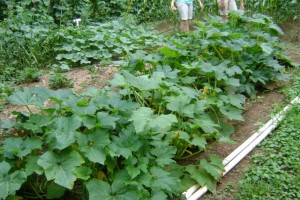
When it was time to plant squash this year, Roy made collars out of items on hand…soda cans, plastic bottles, subway cups, Solo cups, etc. The squash grew well, but as they got bigger and started to lay over, most of the collars were forced over by the weight of the plants. We wondered what we had done wrong and how this could possibly really work.
However, the squash seemed healthy, until we noticed it was covered in nasty little grey bugs and clusters of brown eggs. As with the aphids on the tomatoes, there was a disconcerting number of these guys. About the same time, the plants started looking unhealthy, although they continued to produce well. The assumption, then, was that these bugs were causing the plants to die. Some quick research showed them to be squash bugs. The grey ones we had seen in mass, were the immature version. The adults look just like small stink bugs, and are often mistaken for them. The problem with what I found, though, was that these pests do not cause the type of damage I was seeing. Our plants had begun to die and break off at the ground like last year, at the rate of a couple a day. Squash bugs cause a gradual wilting of the plant.
I went back and investigated the plants themselves and on the most recently deceased, the stems were full of white worms. Cutworms, I assumed. I quickly dusted with a permethrin powder and circled each plant with it and then began to read to see if I could save the rest. To my surprise, I discovered that cutworms most commonly attack tomatoes and peppers. If they were going to get the squash, it would’ve been when they were very small and the collars were still in place. That, I discovered is how the collars work…once the plants are too big for the collars, they are too big for the cutworms. Cutworms work by wrapping around small stems and biting them off clean. This is why the wood slivers work…if the cutworm wraps around and feels the non-succulent wood, it assumes it is not what it is looking for and goes somewhere else.
My squash weren’t cut off clean, they were mushy where they broke off, and having worms inside the stem wasn’t consistent, either. I finally discovered that our problem (both years) was squash vine borers. This was not good news. We had killed the squash bugs and knew how to prevent cutworms (which we have seen no evidence of), but squash vine borers are among the hardest to combat. The adult bug is a moth, that is usually mistaken for a black and orange wasp…due to the shape and movement of it. I remember seeing them this year. They lay their eggs on the squash, and then the larvae bore into the stem of the plant where they feed and grow, eventually causing the base of the stem to rot off.
Many things were suggested from not growing squash, to surrounding the plants with foil to disorient the adult moths. Some extension services give detailed spraying times and methods for large scale growers, which I am not opposed to trying, but the first thing we will try is to cover the squash with a netting tent until time for pollination, and then be watchful. This is only practical, though, on a small scale. For now, I am digging up each plant as it dies (we have lost about half) and killing the worms.
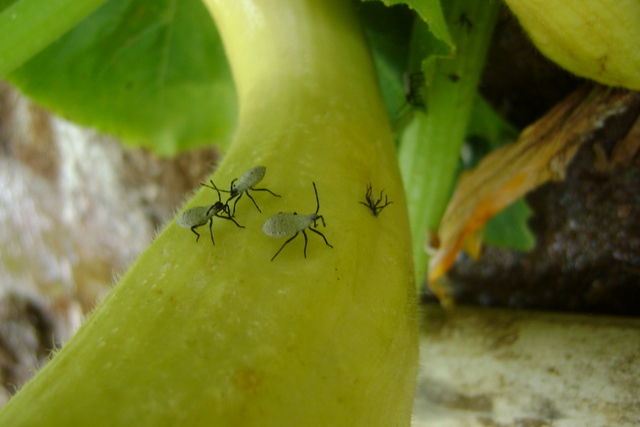
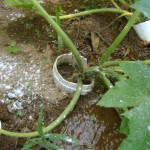
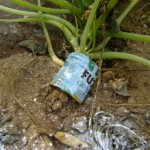
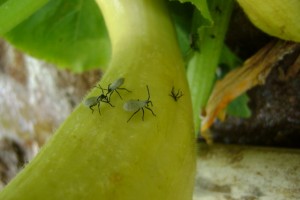

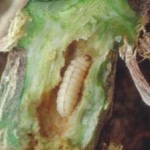
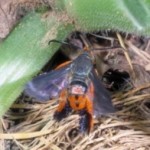
We didn’t have any critters killing/eating our squash – we had squash mosaic virus! In fact, I had to pull out all of my squash – both zucchini and yellow summer – and replant! Hopefully the second crop won’t succumb to the same disease! Luckily, before the plants died back, they produced tons of squash which I have been able to shred and freeze. Thanks for the info about the different critters, now I guess I will have to look out for those also! 😉
This explains why my gigantic squash just gave up overnight and colapsed on itself. I will now be looking for the little critters as I have 2 more plants on the other end of the garden. Great info.